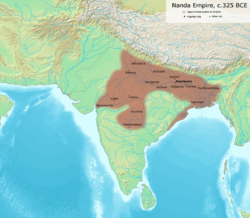Conquest of the Nanda Empire
| Nanda War | |||||||
|---|---|---|---|---|---|---|---|
| Part of Conquests of Chandragupta Maurya | |||||||
 The Nanda Empire during the time of the war. | |||||||
| |||||||
| Belligerents | |||||||
| Nanda Empire | Maurya Empire | ||||||
| Commanders and leaders | |||||||
| Dhana Nanda | Chandragupta Maurya | ||||||
| Strength | |||||||
| Unknown | Unknown | ||||||
| Casualties and losses | |||||||
| Unknown | Unknown | ||||||
The conquest of the Nanda Empire under Dhana Nanda by a small state, somewhere in north western India under Chandragupta Maurya in the 4th century BC led to the establishment of the Maurya Empire. Little is known of the conflict.
Nanda strength
The Nanda Empire was a strong nation based in Magadha and containing many of the kingdoms in the Ganges basin.[1] Its armies were huge, its leaders terrifying. It was a fear for the invading Macedonians of Alexander the Great, a fear leading to a mutiny which ultimately lead to the return of the Macedonian army from the banks of the modern river Beas. Its strength was challenged by the Kingdom of Chandragupta Maurya located in north western India. Under Chandragupta Maurya, it supplanted the long-established and powerful Nanda Empire. According to Plutarch the Nanda Army strength in the east was 200,000 infantry, 80,000 cavalry, 8,000 chariots, and 6,000 war elephants. The forces of Chandragupta remain unknown along with the exact details of the conflict.
War
It is unlikely that a small state could have annexed an empire through a war of outright conquest, thus it is likely that Chandragupta's campaign against the Nanda was probably laid out by using popular guerrilla tactics.[2] After the death of Dhana Nanda, the Nanda Empire was conquered by Chandragupta Maurya. Chandragupta's forces besieged the city of Pataliputra in 320 BC (now Patna). His troops drew a noose gradually tighter around the city until the overwhelmingly superior Nanda Army was defeated. The war brought an end to the Nanda Dynasty and established the Maurya Empire with Chandragupta Maurya as its leader.. In the book by (Chatterjee 1998) the author suggests that "Chandragupta had to engage all his military strength, even Greek mercenaries from Punjab in his conquest of the Nanda king" and according to references about the conquest in the Milinda Panha "One Crore of soldiers, 10,000 elephants, 100,000 horses and 5,000 charioteers were killed in the encounter". [3]
Aftermath
Chandragupta eventually expanded his empire to southern India and warred with the Seleucid Empire over control over all of north western India and parts of Persia. The Maurya Empire eventually became the most extensive empire in India seen up to the date of when he abdicated.